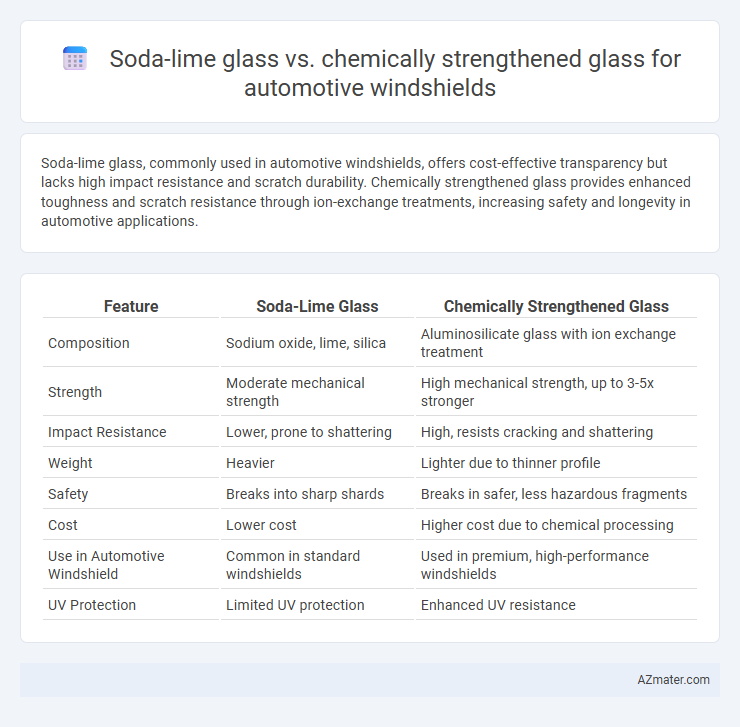Soda-lime glass, commonly used in automotive windshields, offers cost-effective transparency but lacks high impact resistance and scratch durability. Chemically strengthened glass provides enhanced toughness and scratch resistance through ion-exchange treatments, increasing safety and longevity in automotive applications.
Table of Comparison
| Feature | Soda-Lime Glass | Chemically Strengthened Glass |
|---|---|---|
| Composition | Sodium oxide, lime, silica | Aluminosilicate glass with ion exchange treatment |
| Strength | Moderate mechanical strength | High mechanical strength, up to 3-5x stronger |
| Impact Resistance | Lower, prone to shattering | High, resists cracking and shattering |
| Weight | Heavier | Lighter due to thinner profile |
| Safety | Breaks into sharp shards | Breaks in safer, less hazardous fragments |
| Cost | Lower cost | Higher cost due to chemical processing |
| Use in Automotive Windshield | Common in standard windshields | Used in premium, high-performance windshields |
| UV Protection | Limited UV protection | Enhanced UV resistance |
Introduction to Automotive Windshield Materials
Soda-lime glass is the most common material used for automotive windshields due to its low cost and ease of manufacturing, but it lacks the strength and safety features required for impact resistance. Chemically strengthened glass, often made by ion exchange processes, offers enhanced durability and scratch resistance, making it more suitable for high-performance or luxury vehicle windshields. The choice between soda-lime and chemically strengthened glass impacts overall vehicle safety, weight, and cost-efficiency in automotive design.
Overview of Soda-Lime Glass
Soda-lime glass, the most common material for automotive windshields, consists primarily of silica, soda, and lime, offering a balance of cost-effectiveness and durability. Its ease of manufacturing enables large-scale production with consistent optical clarity, although it is more prone to scratching and breakage compared to chemically strengthened glass. Despite lower strength, soda-lime glass is often laminated with plastic interlayers to enhance safety and impact resistance in vehicles.
Overview of Chemically Strengthened Glass
Chemically strengthened glass used in automotive windshields undergoes an ion-exchange process that enhances surface compression, resulting in higher strength and improved resistance to scratches and impacts compared to soda-lime glass. This type of glass maintains superior optical clarity and durability, making it ideal for withstanding harsh environmental conditions and enhancing passenger safety. The increased toughness of chemically strengthened glass reduces the likelihood of shattering upon impact, providing a safer and more reliable windshield solution.
Key Differences in Composition and Manufacturing
Soda-lime glass, primarily composed of silica, sodium oxide, and calcium oxide, undergoes a standard cooling process, making it affordable yet less resistant to impact and thermal stress. Chemically strengthened glass incorporates an ion-exchange process where smaller sodium ions in the glass surface are replaced by larger potassium ions, enhancing its strength and durability significantly. The manufacturing of chemically strengthened glass involves immersion in a molten salt bath, creating a compressive stress layer that soda-lime glass lacks, crucial for automotive windshields requiring increased safety and resistance to cracks.
Mechanical Strength and Durability Comparison
Soda-lime glass, commonly used for automotive windshields, offers moderate mechanical strength but is prone to shattering upon impact due to its composition primarily of silica, soda, and lime. Chemically strengthened glass undergoes an ion-exchange process that significantly increases surface compression, enhancing mechanical strength by up to four times compared to soda-lime glass and providing superior resistance to scratches and breakage. This increased durability makes chemically strengthened glass a preferred choice for high-performance automotive applications where safety and longevity are critical.
Impact Resistance and Safety Performance
Soda-lime glass, commonly used in automotive windshields, offers basic impact resistance but can shatter into large, sharp shards, posing higher injury risks during collisions. Chemically strengthened glass undergoes an ion-exchange process that enhances its surface compression, significantly improving impact resistance and preventing brittle failure under stress. This advanced glass type maintains structural integrity upon impact, ensuring superior safety performance by reducing the likelihood of glass penetration and injury.
Optical Clarity and Visual Performance
Soda-lime glass, commonly used in automotive windshields, provides reliable optical clarity with minimal distortion but is more prone to scratches and impacts, which can degrade visual performance over time. Chemically strengthened glass offers superior optical clarity due to its uniform surface compression, reducing micro-abrasions and maintaining clearer visibility under various lighting conditions. Enhanced visual performance in chemically strengthened glass improves driver safety by minimizing glare and distortion, critical factors for high-speed and night driving.
Cost Efficiency and Manufacturing Scalability
Soda-lime glass offers high cost efficiency due to its inexpensive raw materials and well-established manufacturing processes, making it ideal for mass production in automotive windshields. Chemically strengthened glass, though more expensive because of additional ion-exchange treatments, provides superior durability and scratch resistance, reducing long-term replacement costs. Manufacturing scalability favors soda-lime glass with faster throughput and lower energy consumption, while chemically strengthened glass requires specialized equipment limiting large-scale production speed.
Sustainability and Environmental Considerations
Soda-lime glass, commonly used in automotive windshields, offers ease of recycling and lower energy consumption during production, enhancing its sustainability profile. Chemically strengthened glass provides superior durability and resistance to damage, potentially extending windshield lifespan and reducing waste frequency. Evaluating environmental impact involves balancing soda-lime's recyclability with chemically strengthened glass's longer service life, influencing overall automotive ecological footprints.
Future Trends in Automotive Windshield Glass Technology
Soda-lime glass remains the industry standard for automotive windshields due to its cost-effectiveness and ease of manufacturing, but chemically strengthened glass is gaining traction because of its superior strength and scratch resistance, which enhance safety and durability. Future trends indicate a shift toward combining chemically strengthened glass with advanced coatings and smart technologies, such as augmented reality heads-up displays and solar control functions, to improve driver experience and energy efficiency. Innovations in lamination techniques and integrated sensors also suggest that chemically strengthened glass will play a pivotal role in the next generation of smart, high-performance automotive windshields.

Infographic: Soda-lime glass vs Chemically strengthened glass for Automotive windshield
 azmater.com
azmater.com